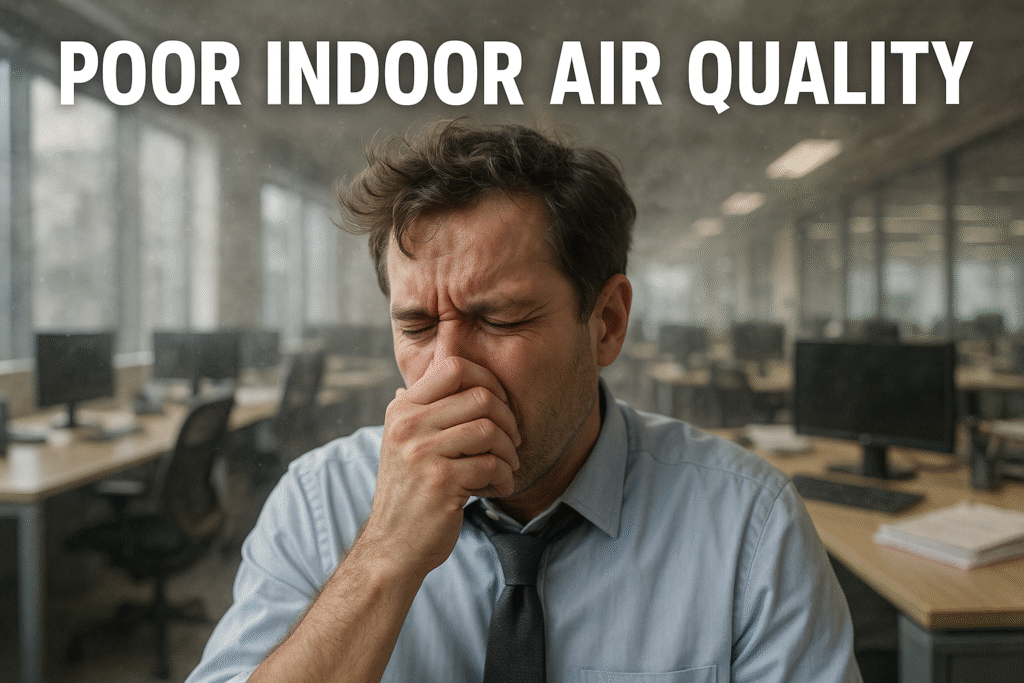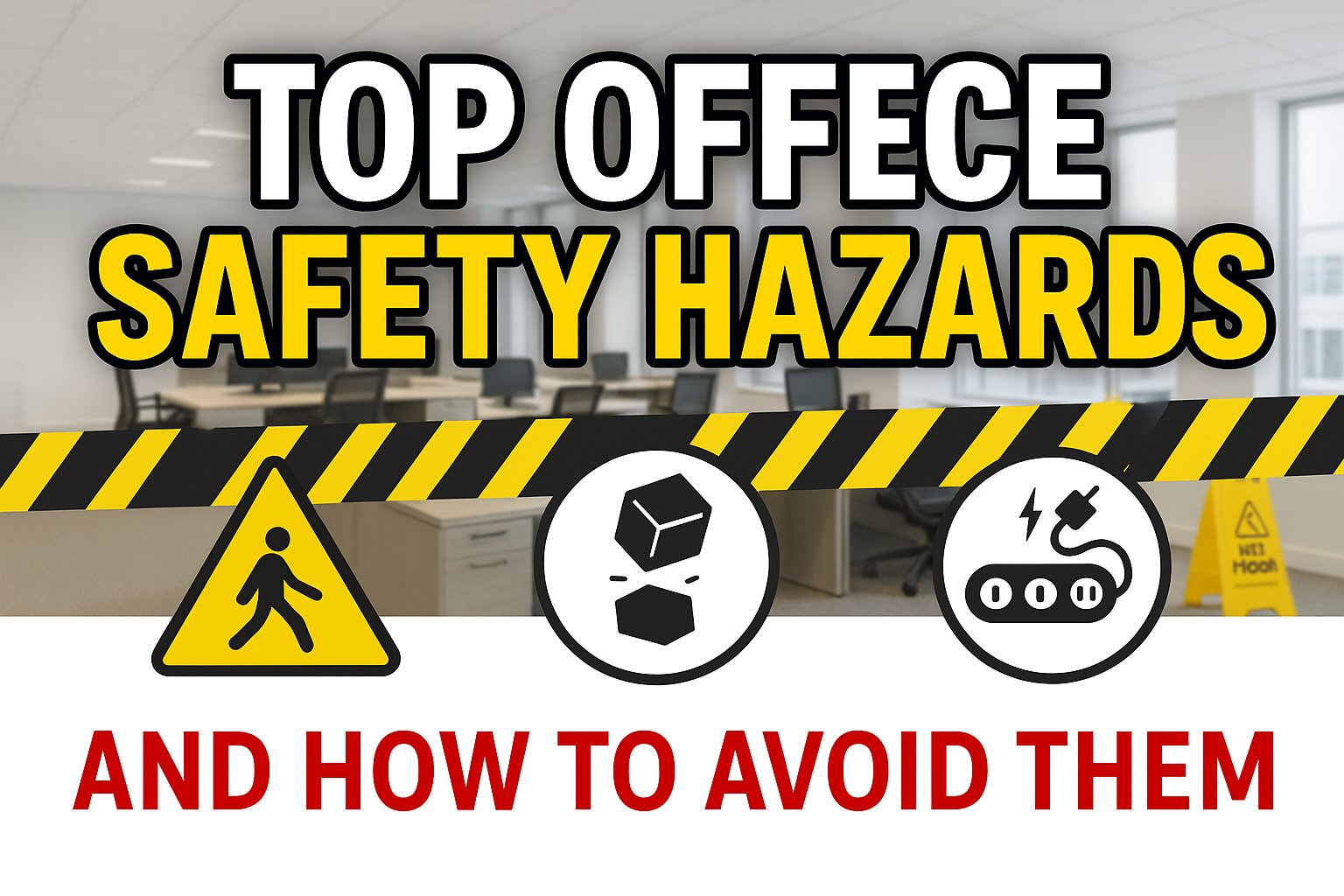Top Office Safety Hazards are often overlooked in the rush of daily business, but ignoring them can lead to injuries, reduced productivity, and costly claims.
At the beginning of any safety program, identifying these hazards and implementing controls is critical to keeping employees healthy and the organization compliant.

This essential guide will walk you through the Top Office Safety Hazards you need to know about and provide practical strategies to avoid them.
- Understanding Top Office Safety Hazards
- 1. Slips, Trips, and Falls
- 2. Ergonomic Injuries
- 3. Electrical Hazards
- 4. Fire Hazards
- 5. Poor Indoor Air Quality
- 6. Chemical Hazards
- 7. Stress and Mental Health Risks
- 8. Manual Handling and Storage Hazards
- 9. Workplace Violence
- 10. Clutter and Poor Housekeeping
- Best Practices for Managing Top Office Safety Hazards
- Final Thoughts on Top Office Safety Hazards
Understanding Top Office Safety Hazards
Office environments might seem benign compared to factories or construction sites, but they harbor risks that can lead to serious incidents.
Recognizing these Top Office Safety Hazards helps businesses protect their workers while meeting legal requirements.
From slips and trips to ergonomic issues, let’s explore them in detail and learn how to mitigate each one.
1. Slips, Trips, and Falls
Among the Top Office Safety Hazards, slips, trips, and falls are consistently the most reported. They can happen due to:
- Wet floors
- Loose carpeting
- Cluttered walkways
- Poor lighting
How to Avoid Them:
- Ensure floors are clean and dry.
- Use non-slip mats near entrances.
- Keep walkways clear of clutter and cables.
- Maintain adequate, even lighting.
For more on trip prevention, see Canadian Centre for Occupational Health and Safety (DoFollow link).
2. Ergonomic Injuries
Poor workstation design is a key Top Office Safety Hazard. Improper chair height, monitor positioning, or repetitive movements can cause musculoskeletal disorders (MSDs).
How to Avoid Them:
- Provide adjustable chairs and desks.
- Train workers on proper posture.
- Encourage frequent breaks and stretching.
- Conduct ergonomic assessments regularly.
Internal link example: Learn how Training and Safety Awareness improves injury prevention.
3. Electrical Hazards
Electrical risks may not be obvious, but they’re serious Top Office Safety Hazards. Overloaded power strips, frayed cords, or improper equipment use can cause shocks or fires.
How to Avoid Them:
- Inspect cords regularly for damage.
- Avoid daisy-chaining power strips.
- Ensure equipment is grounded.
- Educate staff on electrical safety basics.
For a deeper dive, see WorkSafeBC’s Electrical Safety Guidelines.
4. Fire Hazards
Fires can devastate offices quickly. Common causes include faulty wiring, overloaded circuits, flammable materials stored improperly, or blocked exits.
How to Avoid Them:
- Maintain clear, unobstructed emergency exits.
- Store flammable materials properly.
- Inspect and maintain fire extinguishers.
- Conduct regular fire drills and training.
Note: Having a clear evacuation plan is mandatory under most national codes.
5. Poor Indoor Air Quality
Indoor air quality is another underappreciated Top Office Safety Hazard. Pollutants, allergens, and inadequate ventilation can trigger headaches, respiratory issues, or allergies.

How to Avoid Them:
- Maintain HVAC systems.
- Use low-VOC materials where possible.
- Control mold and moisture.
- Allow fresh air circulation.
For further reading, check EPA’s Office Indoor Air Quality Guide.
6. Chemical Hazards
Even offices use cleaning agents, printer toner, or adhesives that may pose chemical risks—a critical Top Office Safety Hazard.
How to Avoid Them:
- Label all chemicals correctly.
- Provide Safety Data Sheets (SDS).
- Train staff in safe handling and storage.
- Use proper ventilation.
This links to our internal guide on Preventing Chemical Exposure in Auto Repair Shops—while for shops, many principles still apply.
7. Stress and Mental Health Risks
Psychosocial hazards are increasingly recognized as Top Office Safety Hazards. High workloads, harassment, poor communication, or lack of support can harm mental health.
How to Avoid Them:
- Promote work-life balance.
- Provide access to mental health resources.
- Foster respectful, inclusive communication.
- Train managers to recognize and address stress.
See our internal post on Psychological Safety: Building a Mentally Healthy Workplace.
8. Manual Handling and Storage Hazards
Lifting boxes, shifting supplies, or retrieving items from high shelves can cause back injuries or strains. It’s a subtle but real Top Office Safety Hazard.
How to Avoid Them:
- Train staff in safe lifting techniques.
- Provide step stools or ladders for high storage.
- Keep heavier items on lower shelves.
- Encourage team lifts for bulky items.
9. Workplace Violence
While rare in many offices, violence—including bullying, harassment, or physical threats—is a serious Top Office Safety Hazard.
How to Avoid Them:
- Establish clear anti-harassment policies.
- Offer conflict-resolution training.
- Provide confidential reporting channels.
- Take all threats seriously and investigate thoroughly.
10. Clutter and Poor Housekeeping
Simple disorganization is a surprisingly common Top Office Safety Hazard. Boxes in hallways, messy desks, and overfilled storage rooms lead to accidents and hinder evacuations.
How to Avoid Them:
- Enforce regular housekeeping routines.
- Organize storage areas with labels and shelves.
- Dispose of waste and recyclables promptly.
- Include housekeeping checks in safety audits.
Best Practices for Managing Top Office Safety Hazards
Tackling Top Office Safety Hazards isn’t about one-time fixes—it requires a culture of safety. Consider these broader strategies:
- Conduct regular risk assessments.
- Involve workers in identifying hazards.
- Offer ongoing safety training.
- Maintain clear policies and procedures.
- Review and improve plans annually.
By making safety an everyday priority, you not only comply with legal standards but also improve employee satisfaction and productivity.
Final Thoughts on Top Office Safety Hazards
Identifying and controlling Top Office Safety Hazards is essential for any modern workplace. From simple housekeeping to supporting mental health, every hazard deserves attention.
Businesses that invest in safety reap rewards in the form of fewer injuries, lower costs, and a more engaged workforce.

For more tips, explore OHSE.ca for safety guides, training resources, and best practices that help organizations build a true culture of prevention.

No comments yet